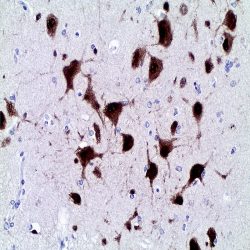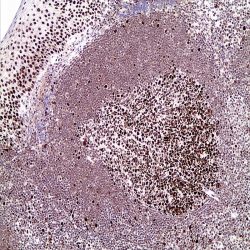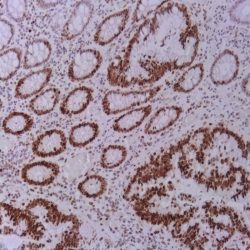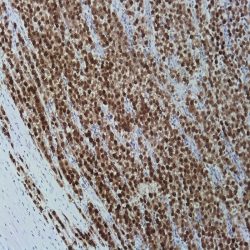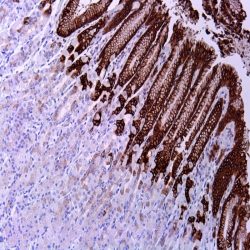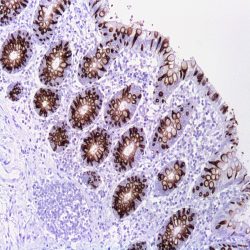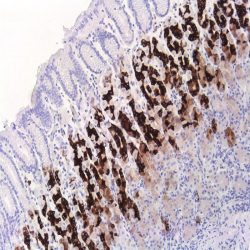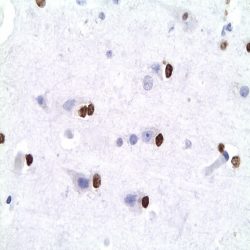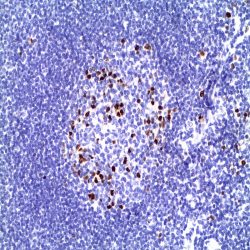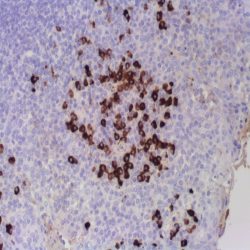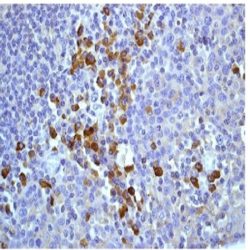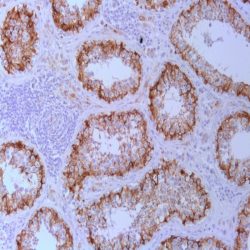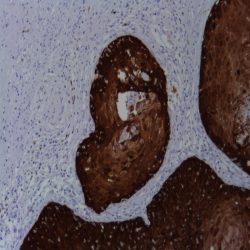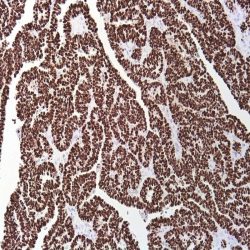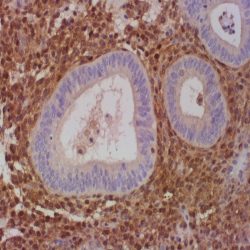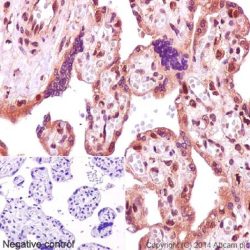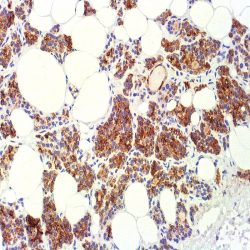Archives: فروشگاه
Showing 201–220 of 651 results
فیلتر ها-
آنتی بادیهای ایمونوهیستوشیمی
آنتی بادی Nestin (10C2)
Rated 0 out of 5Name: Mouse anti-human Nestin Monoclonal Antibody clone 10c2
Description and applications: Nestin is a class VI intermediate filament (IF) protein. It has been reported that nestin expression is significantly increased in melanoma and correlated with more advanced stages of the disease. An immunohistochemical analysis identified nestinpositive cells in 84% of primary melanoma and 83% of metastatic melanoma. Nestin immunoreactivity was also observed in melanoma cells in all cases of HMB45-negative amelanotic and melanotic, nondesmoplastic melanoma. Nestin expression has been reported in tumors of the CNS, including astrocytoma, ependymoma, oligodendroglioma, glioblastoma, and primitive neuroectodermal tumors. Nestin has been detected in human gliomas, including low and high grade, but its expression is observed more frequently in high grade than in low grade gliomas. Nestin overexpression is seen in carcinomas, including prostatic adenocarcinoma, pancreatic ductal carcinoma, thyroid carcinoma, and in mesenchymal tumors such as GIST and DFSP. Among the breast carcinoma subtypes, Nestin is highly expressed in basal breast cancer subtype (ERα-/PR-/Her2-) but not in the Her2 subtype (ERα-/PR-/Her2+) or luminal epithelial phenotype (ERα+/PR+). Only cytoplasmic staining is considered positive, whereas any nuclear staining is considered as background artifact. In normal skin, nestin is observed in endothelial cells and the bulge area of hair follicles.
Composition: Anti-human Nestin mouse monoclonal antibody purified from serum and prepared in 10mM PBS, pH 7.4, with 0.2% BSA and 0.09% sodium azide
Intend use : Immunohistochemistry (IHC) on paraffin embedded tissues. Not tested on frozen tissues or Western-Blotting
-
آنتی بادیهای ایمونوهیستوشیمی
آنتی بادی NeuN Protein (A60)
Rated 0 out of 5Name: Neuronal Nuclear Protein (NeuN)-clone A60
Description and aplications: NeuN antibody (NEUronal Nuclei; clone A60) specifically recognizes the DNA-binding, neuron-specific protein NeuN, which is present in most CNS and PNS neuronal cell types of all vertebrates. NeuN protein distributions are apparently restricted to neuronal nuclei, perikarya and some proximal neuronal processes in both fetal and adult brain although, some neurons fail to be recognized by NeuN at all ages: INL retinal cells, Cajal-Retzius cells, Purkinje cells, inferior olivary and dentate nucleus neurons, and sympathetic ganglion cells are examples. Immunohistochemically detectable NeuN protein first appears at developmental timepoints that correspond with the withdrawal of the neuron from the cell cycle and/or with the initiation of terminal differentiation of the neuron. Immunoreactivity appears around E9.5 in the mouse neural tube and is extensive throughout the developing nervous system by E12.5. Strong nuclear staining suggests a nuclear regulatory protein function; however, no evidence currently exists as to whether the NeuN protein antigen has a function in the distal cytoplasm or whether it is merely synthesized there before being transported back into the nucleus. No difference between protein isolated from purified nuclei and whole brain extract on immunoblots has been found. The A60 antibody is a neuronal widely used tumor marker. NeuN is expressed in the neuronal component gangliogliomas , ganglioneuromas , Lhermitte -Duclos disease ( gangliocytoma with cerebellar dysplasia) , neurocitomas , in well-differentiated neurons and the oligodendrocytes like component present in dysembryoplastic neuroepithelial tumors . The expression in over 60% of the cells in glial tumors has been referenced in specific cases (1 oligodendroglioma , 3 glioblastomas and one clear cell ependymoma from over 600 cases studied ) . NeuN is often negative in the component neuronal ganglion cell tumors in particular when it is morphologically differentiated . This antibody cross-reacts with other species (mouse, rat, pig , etc.).
Composition: anti- Neuronal Nuclear Protein (NeuN) mouse monoclonal antibody obtained from supernatant culture and prediluted in a tris buffered solution pH 7.4 containing 0.375mM sodium azide solution as bacteriostatic and bactericidal. The quantity of the active antibody was not determined.
Immunogen: Purified cell nuclei from mouse brain
-
آنتی بادیهای ایمونوهیستوشیمی
آنتی بادی Neurofilament 70/200 kDa (2F11)
Rated 0 out of 5Name: Neurofilament 70/200 kDa Antibody-Clone 2F11
Description and aplication: AntiNeurofilament antibody stains an antigen localized in a number of neural, neuroendocrine, and endocrine tumors. Neuromas, ganglioneuromas, gangliogliomas, ganglioneuroblastomas and neuroblastomas stain positively for neurofilament. Neurofilaments are also present in paragangliomas and adrenal and extraadrenal pheochromocytomas. Carcinoids, neuroendocrine carcinomas of the skin, and oat cell carcinomas of the lung also express neurofilament.
Composition:Anti-human Neurofilament mouse monoclonal antibody purified from serum and prepared in 10mM PBS, pH 7.4, with 0.2% BSA and 0.09% sodium azide.
-
آنتی بادیهای ایمونوهیستوشیمی
آنتی بادی MSH2 (FE11)
Rated 0 out of 5Name: MSH2 (MutS Protein Homolog 2) Mouse] Antibody Clone FE11
Description and applications: MSH2 is involved in DNA repair as a mismatch repair protein, and mutations of MSH2 are found in approximately 50% of inherited non polyposis colorectal carcinoma (HNPCC) (Lynch syndrome) cases. HNPCC is an autosomal, dominantly inherited disease associated with marked increase in cancer susceptibility. It is characterized by a familial predisposition to early onset colorectal carcinoma and extra-colonic cancers of the gastrointestinal, urological and female reproductive tracts.
Composition: anti-human MSH2 mouse monoclonal antibody purified from ascites fluid by Protein A chromatography. Prepared in 10mM PBS, pH 7.4, with 0.2% BSA and 0.09% sodium azide.
-
آنتی بادیهای ایمونوهیستوشیمی
آنتی بادی MSH6 (EP49)
Rated 0 out of 5Name: MSH6 Antibody (Clone EP49)
Description and aplications: The MutS homologue 6 protein (MSH6) is a member of the MutS homolog family required in the DNA match repair system.Carriers of the mismatch repair gene mutations have a high lifetime risk of developing Hereditary Non-Polyposis Colon Cancer (HNPCC) and several other cancers including endometrial cancer due to microsatellite instability (MSI) caused by accumulation of DNA replication errors in proliferating cells. MSH6 antibody is useful for screening and diagnosis of patients with MSI. The level of MSI has been reported to be associated with prognosis in colon cancer. Adding of PMS2 and MSH6 to MLH1 and MSH2 antibodies increased sensitivity for diagnosis of MSI. Tumors with low-level MSI show unfavourable pathological characteristics compared to tumours with no and tumours with high-level MSI.
Composition: anti-human MSH6 rabbit monoclonal antibody purified from ascites. Prepared in 10mM PBS, pH 7.4, with 0.2% BSA and 0.09% sodium azide.
-
آنتی بادیهای ایمونوهیستوشیمی
آنتی بادی Oct3/4 (C-10)
Rated 0 out of 5Name: Mouse Anti-OCT 3/4 Monoclonal Antibody
Description and aplications: OCT-3 (officially POU5F1, also known as OCT4, OCT 3/4, OTF3 or OTF4) is a nuclear transcription factor involved in the initiation, maintenance and differentiation of germ cells and stem cells during embryonic development. The antibody recognizes a protein of 18kDa molecular weight encoded by the gene POU5F1 located on chromosome 6p21.3 which is essential in the development of the blastocyst. Three isoforms of OCT-3-called OCT-3A, OCT-3B and OCT3B1 are generated by alternative splicing. Isoforms A and B1 are expressed only in germ cell tumors while OCT3B isoform may also be expressed in tumors of somatic origin. This antibody is useful for the identification of transcription factor OCT-3/4 present in normal tissues (embryonic testis) and neoplastic ones. Gonadoblastomas, intratubular germ cell tumors, testicular seminoma, ovarian dysgerminomas, extragonadal germinomas and embryonal carcinoma show nuclear positivity with different degrees of intensity. By contrast the yolk sac tumors, spermatocytic seminomas, choriocarcinoma, testicular and ovarian teratomas are negative. Its expression has also been demonstrated in several tumor lines of somatic origin and linked to poor prognosis
Composition: anti-OCT3/4 mouse monoclonal antibody obtained from supernatant culture and prediluted in a tris buffered solution pH 7.4 containing 0.375mM sodium azide solution as bacteriostatic and bactericidal.
Immunogen: amino acids 1-134 of Oct-3/4 of human origin
-
آنتی بادیهای ایمونوهیستوشیمی
آنتی بادی Mucin 5AC (MUC5AC) (MD-19 also known as MRQ-19)
Rated 0 out of 5Name: Mucin 5AC (MUC5AC) Antibody (Clone MUC5AC, MD-19 also known as MRQ-19)
Description and applications: Mucins are glycoproteins of high molecular weight linked to oligosaccharides in the threonine or serine wastes by glycosidic bonds produced by different epithelial cells. In humans, at least 14 genes coding for mucins have been identified (MUC1, MUC2, MUC3, MUC4, MUC5AC, MUC5B, MUC6, MUC7, MUC8, MUC9, MUC11, MUC12, MUC13 and MUC16). Mucins are classified as follows: Membrane-bound mucins (MUC1, MUC3, MUC4, MUC12 and MUC16), secreted mucins forming gel-like secretion (MUC2, MUC5AC, MUC5B, and MUC6) and secreted soluble mucin (MUC7). Mucins are the main component of the mucous membrane that protects the gastric mucosa from the chemical and mechanical insults. This antibody reacts with the mucin 5AC. MUC5AC isthe glycoprotein secreted forming gel-like secretions expressed by the gastric epithelium and the respiratory tract. The distribution of the expression of the mucins is heterogeneous MUC1 (stomach and pancreas), MUC2 (small and large intestine), MUC4 (stomach), MUC5AC (stomach) and MUC6 (stomach, small intestine and pancreas). MUC5AC is expressed in apical rim in normal cells and also in the lateral edges of the cytoplasmic membrane and intracytoplasmically in carcinomas of different tissues. MUC5AC is expressed in normal gastric epithelium in the cardia, fundus and pyloric antrum. Barrett’s esophagus shows positivity for this mucin; MUC5AC is not expressed in the small intestine, large intestine nor pancreas. In neoplastic tissues, it is expressed in pancreatic, colon and appendix adenocarcinomas, extramammary Paget’s disease Colloid carcinomas of the breast nor cholangiocarcinomas in general do not express MUC5AC. The mucin expression pattern in tumors has been associated with the tumor location, the biological insult and the infiltration capacity of some neoplasias.
Composition: Anti-human Mucin 5AC mouse monoclonal antibody purified from serum and prepared in 10mM PBS, pH 7.4, with 0.2% BSA and 0.09% sodium azide.
-
آنتی بادیهای ایمونوهیستوشیمی
آنتی بادی Mucin 2 (Ccp 58)
Rated 0 out of 5Name: Mucin 2 (MUC-2) Antibody (Clone Ccp58)
Description and applications: Secreted epithelial mucins are large macromolecules which exhibit extreme polydispersity. Mucin 2 is the major intestinal mucin. O-glycans are attached to MUC2 in a potentially diverse arrangement, which is crucial for their interaction with endogeneous and exogeneous lectins. MUC2 is expressed in glandular epithelium (goblet cells) of normal small and large intestine, Barrett’s esophagus and breast glandular epithelium; it is not expressed in stomach or pancreas. In neoplastic tissues the pattern of mucins expression in tumours has been associated with tumor location, the biological aggressiveness and the infiltration capacity of certain malignancies. MUC2 is expressed by colon and appendix signet ring adenocarcinomas, breast colloid carcinoma, Paget’s disease of the breast and prostate carcinoma. It is not expresses by endometrial carcinomas, the non-mucinous breast or pancreatobiliary carcinomas.
Composition: anti-human MUC-2 mouse monoclonal antibody purified from serum and prepared in 10mM PBS, pH 7.4, with 0.2% BSA and 0.09% sodium azide.
-
آنتی بادیهای ایمونوهیستوشیمی
آنتی بادی Mucin 6 (MD-20 also known as MRQ-20)
Rated 0 out of 5Name: Anti-Mucin 6 (MUC6) Antibody (Clone MRQ-20)
Description and aplications: Mucins are high molecular weight glycoproteins produced by epithelial cells. In humans, at least 14 genes encoding mucin has been identified (MUC1, MUC2, MUC3, MUC4, MUC5AC, MUC5B, MUC6, MUC7, MUC8, MUC9, MUC11, MUC12, MUC13 and MUC16). Mucins are classified as membrane associated (MUC1, MUC3, MUC4, MUC12 and MUC16), secreted mucins forming gels (MUC2, MUC5AC, MUC5B, and MUC6), or soluble secreted mucin (MUC7). Mucins are the major component of the mucus layer which protects against chemical and mechanical gastric mucosa aggression. MUC6 is expressed in the normal gastric epithelium of the pyloric antrum, in Brüner duodenal glands, small intestine, and pancreas; MUC6 is not expressed in ducts or acini of normal breasts or Barrett’s esophagus. In neoplastic tissues MUC6 is expressed in colloidal breast carcinomas. Breast carcinomas, pancreatic adenocarcinomas and cholangiocarcinomas do not express MUC6. The pattern of mucin expression in tumors has been associated with tumor location, the biological aggressiveness, and the infiltration capacity of certain malignancies.
Composition: anti-MUC-6 mouse monoclonal antibody obtained from supernatant culture and prediluted in a tris buffered solution pH 7.4 containing 0.375mM sodium azide solution as bacteriostatic and bactericidal.
-
آنتی بادیهای ایمونوهیستوشیمی
آنتی بادی Olig 2 Protein (211F1.1)
Rated 0 out of 5Name: Olig 2 Protein Antibody-Clone 211F1.1
Description and applications: Olig2, a basic helix–loop–helix transcription factor, is involved in oligodendroglial specification. Olig2 expression has been reported in most glial tumors, such as oligodendrogliomas and astrocytomas. Although more than half of glioblastomas are positive for Olig2, expression is very weak in terms of both percentage of labeled cells and intensity. No Olig2 expression has been found in the non-glial tumors including neuroepithelial tumors, ependymomas, subependymomas, medulloblastomas, and nonneuroepithelial tumors, such as CNS lymphomas, meningiomas, schwannomas, atypical teratoid/rhabdoid tumor, and haemangioblastomas. Compared to the strong staining seen in glioma samples, a weak expression is observed in nontumoral brain tissue (gliosis). In order to characterize cellular subtypes that constitute astrocytomas, oligoastrocytomas and oligodendrogliomas, double labeling of Olig2 and GFAP has been performed which identified two phenotypically distinct tumor populations. The first is Olig2+/GFAP– which has an oligodendroglial morphology, corresponding to pure oligodendrogliomas that contain only oligodendroglial cells; the second is Olig2–/GFAP+ which has an astrocytic phenotype, including not only oligoastrocytomas, but also WHO astrocytomas. Depending on proportion and spatial clustering of the two phenotypically distinct tumor populations, the tumor (Olig2-/GFAP+) is classified either as an astrocytoma when both populations are intermingled with a dominance of GFAP+ cells or oligoastrocytoma when there is some degree of spatial clustering of the GFAP+ cells.
Composition: anti-human Olig 2 protein mouse monoclonal antibody purified from serum and prepared in 10mM PBS, pH 7.4, with 0.2% BSA and 0.09% sodium azide.
-
آنتی بادیهای ایمونوهیستوشیمی
آنتی بادی MUM1/IRF4 (MUM1p)
Rated 0 out of 5Name: MUM1 Antibody (Clone MUM1p)
Description and aplications: MUM1 / IRF4 is an oncogene associated with myeloma. The protein has a molecular weight of 51.6 kDa and is encoded by a gene on chromosome 6p25-p23 region located mainly in the nucleus of lymphocytes. When MUM1 is not expressed, the B / T cells do not get activated and the immunoglobulins are not secreted by the plasma cells. Most neoplasms composed of mature lymphoid cells express MUM1. Therefore, this protein is expressed in a subset of B cells in the germinal center in plasma cells and in activated T cells. MUM1 is a marker that helps in characterizing the histogenesis of lymphoma / leukemia of B origin. In Bcell lymphomas, MUM1 expression presents a predictive role of the genetic profile and represents, together with CD10 and BCL-6, the base of Hans classification for diffused large B cell lymphomas. MUM1 positivity, in these cases, suggests a non-germinal center phenotype and is predictive for prognosis, especially in pediatric cases. In Burkitt lymphomas, that shares cytological, architectural and histological aspects with some cases of DLBCL of “Burkitt-like”, the MUM1 is negative in general or positive in a small percentage of cases or tumoral cells. All cases of primary effusion lymphomas and most cases of primary brain lymphomas are MUM1 positive. Other lymphoid neoplasm express MUM1. Melanomas can also stain with MUM1.
Composition: anti-MUM1 mouse monoclonal antibody obtained from supernatant culture and prediluted in a tris buffered solution pH 7.4 containing 0.375mM sodium azide solution as bacteriostatic and bactericidal.
-
آنتی بادیهای ایمونوهیستوشیمی
آنتی بادی Lambda Inmunoglobulin Light Chain (EP172)
Rated 0 out of 5Name: Lambda light chain Antibody (Clone EP172)
Description and applications: Each immunoglobulin molecule consists of two identical heavy chains and two identical light chains. There are two types of light chains designated as kappa and lambda. The gene rearrangement process that generates the immunoglobulin molecule results in either a productive kappa or lambda gene. The mechanics of the rearrangement process normally produce approximately twice as many kappa-bearing cells as lambda. However this ratio is lost during malignant transformation. The kappa light chain antibody labels kappa light chain expressing B lymphocytes and plasma cells. Other cells may also express kappa light chain due to nonspecific uptake of immunoglobulin.
Composition: anti-human Lambda light chain rabbit monoclonal antibody purified from serum and prepared in 10mM PBS, pH 7.4, with 0.2% BSA and 0.09% sodium azide.
-
آنتی بادیهای ایمونوهیستوشیمی
آنتی بادی Kappa Immunoglobulin Light Chain (EP171)
Rated 0 out of 5Name: Kappa light chain Antibody (Clone EP171)
Description and applications: Each immunoglobulin molecule consists of two identical heavy chains and two identical light chains. There are two types of light chains designated as kappa and lambda. The gene rearrangement process that generates the immunoglobulin molecule results in either a productive kappa or lambda gene. The mechanics of the rearrangement process normally produce approximately twice as many kappa-bearing cells as lambda. However this ratio is lost during malignant transformation. The kappa light chain antibody labels kappa light chain expressing B lymphocytes and plasma cells. Other cells may also express kappa light chain due to nonspecific uptake of immunoglobulin. Individual B cells express either kappa or lambda light chains. Monoclonality is generally assumed to be evidence of a malignant proliferation. The pairing of an antilambda with a kappa light chain antibody is useful for identifying monoclonality of lymphoid malignancies.
Composition: anti-human Kappa light chain rabbit monoclonal antibody purified from serum and prepared in 10mM PBS, pH 7.4, with 0.2% BSA and 0.09% sodium azide.
-
آنتی بادیهای ایمونوهیستوشیمی
آنتی بادی Osteocalcin (G5)
Rated 0 out of 5Name: Osteocalcin Antibody-Clone G5
Description and applications: Bone γ carboxyglutamic acid (Gla) protein, known as BGLAP, BGP or osteocalcin, is an abundant, non-collagenous protein component of bone that is produced by osteoblasts. In mice, osteocalcin is composed of a cluster of three genes known as OG1, OG2 and ORG, all of which can be found within a 23 kb span of genomic DNA. Human osteocalcin is a highly conserved, 46-50 amino acid, single chain protein that contains three vitamin K-dependent γcarboxyglutamic acid residues. Osteocalcin appears transiently in embryonic bone at the time of mineral deposition, where it binds to hydroxyapatite in a calcium-dependent manner. In addition, osteocalcin is one of the most abundant, non-collagenous proteinsfound in mineralized adult bone. Genetic variation at the osteocalcin locus on chromosome 1q impacts postmenopause bone mineral density (BMD) levels and may predispose some women to osteoporosis.
Composition: Anti-human Osteocalcin rabbit polyclonal antibody purified from serum and prepared in PBS with < 0.1% sodium azide and 0.1% gelatin.
IMMUNOGEN: antibody raised against amino acids 1-100 representing full length osteocalcin of human origin.
-
آنتی بادیهای ایمونوهیستوشیمی
آنتی بادی p16-INK4 (MX007)
Rated 0 out of 5Name: P16 INK4A Antibody-Clone MX007
Description and applications: As one of the cyclindependent kinase inhibitors that inhibit cylcindependent kinases 4 and 6, p16 INK4A is encoded by tumor suppressor gene CDKN2A. The tumor suppressor p16 INK4A plays an important role in cell cycle regulation. Increased expression of the p16 gene, which is seen as organisms ages, reduces the proliferation of stem cells. This reduction in the division and production of stem cells protects against cancer while increasing the risks associated with cellular senescence. Mutations in the p16 gene associated with loss or over expression of the protein are associated with increased risk of a wide range of cancers and cancer precursor lesions. The immunohistochemical identification of p16 is particularly relevant in uterine cervical lesions. Development of dysplasia is closely related to human papilloma virus (HPV) infection. Although the frequency of p16INK4a abnormalities is higher in tumor-derived cell lines than in unselected primary tumors, significant subsets of clinical cases with aberrant p16INK4a gene have been reported among melanomas, gliomas, esophageal, pancreatic, lung, and urinary bladder carcinomas, and some types of leukemia.
Composition: anti-human p16INK4A mouse monoclonal antibody purified from serum and prepared in 10mM PBS, pH 7.4, with 0.2% BSA and 0.09% sodium azide.
-
آنتی بادیهای ایمونوهیستوشیمی
آنتی بادی P40 (ZR8)
Rated 0 out of 5Name:Anti-human p40Rabbit Monoclonal Antibody (Clone ZR8)
Description and applications: P63 consists of two major isoforms-TAp63 and ΔNp63. These isoforms differ in the structure of the Nterminal domains. The TAp63 isoform (identified by anti-p63 antibody) contains a transactivation-competent ‘TA’ domain with homology to p53, which regulates the expression of the growth-inhibitory genes. In contrast, ΔNp63 isoform (identified by anti-p40 antibody) contains an alternative transcriptionally-inactive ‘ΔN’ domain, which antagonizes the activity of TAp63 and p53. The p40 (clone ZR8) antibody recognizes exclusively ΔNp63 but not TAp63. p40 is a squamous cell carcinoma ‘specific’ antibody. It reacts with the vast majority of cases of squamous cell carcinomas of various origins, but not with adenocarcinomas. It is particularly useful in differentiating lung squamous cell carcinoma from lung adenocarcinoma. p40 antibody can also be used as an alternative basal cell/myoepithelial cell marker, which has similar sensitivity and specificity as that of p63 antibody. Therefore, p40 antibody may also be used as an alternative immunohistochemical markerfor determining prostate adenocarcinoma vs. benign prostate glands and for determining breast intraductal carcinoma vs. invasive breast ductal carcinoma.
Composition: anti-human p40 rabbit monoclonal purified antibody in 0.2% BSA and 15mM sodium azide.
Immunogen: Synthesized polypeptides from Nterminal domain of p63.
-
آنتی بادیهای ایمونوهیستوشیمی
آنتی بادی p53 (SP5)
Rated 0 out of 5Name: Rabbit anti-human p53 Monoclonal Antibody
Description and applications: p53 is a tumour suppressor gene expressed in a wide variety of tissue types and is involved in regulating cell growth, replication, and apoptosis. The p53 gene is located on chromosome 17p, a frequent location in the loss of alleles in many tumors such as lung, colon, breast and brain. p53 expression is associated with a poor prognosis in breast cancer. In colon tumors, the p53 protein is expressed in 47% of cancers and only 9% of adenomas. In addition, p53 mutations are associated with a large number of malignant tumors, including ovarian, bladder and melanomas.
Composition: anti-human p53 rabbit monoclonal antibody purified from ascites. Prepared in 10mM PBS, pH 7.4, with 0.2% BSA and 0.09% sodium azide
Immunogen: Recombinant human full length wild type p53 protein
-
آنتی بادیهای ایمونوهیستوشیمی
آنتی بادی PTEN (6H2.1)
Rated 0 out of 5Name: PTEN Antibody (Clone 6H2.1)
Description and aplications: The antibody recognizes a protein fraction of 403 amino acids encoded by the PTEN gene located on chromosome 10q23.3 region. PTEN protein acts as a dual specificity phosphatase. On one hand, it dephosphorylates the phosphorylated proteins in tyrosine, serine, and threonine residues and on the other hand, it acts as a lipid phosphatase removing the phosphate group of the D3 position of the inositol ring in phosphatidylinositol-3,4,5-trisphosphate, phosphatidylinositol-3,4-diphosphate, phosphatidylinositol-3-phosphate, and inositol 1,3,4,5- tetrakisfosfato. This last feature is critical to act as a tumor suppressor through the negative regulation of the signaling pathway PI3K-AKT / PKB. This latter controls cell cycle progression, the tissue development, cell migration, and inhibition of apoptosis. In this signaling pathway, PTEN antagonistic effect on PI3K-AKT / PKB also maintains the stability of p53. PTEN also controls other cell cycle proteins such as p27, p130, myc, and cyclin D1. PTEN gene mutations induce alterations in the functioning of cells in a manner that the loss of PTEN protein expression is associated with tumor genesis, cancer progression, and cancer-resistance to different
treatments. Due to its role in cell growth, the vast majority of normal tissues express high amount of the PTEN protein. The loss of PTEN protein expression was observed in some malignancies associated with abnormalities in the PTEN gene. These abnormalities
can be monoallelic (gliomas and carcinomas of breast, prostate, lung, and colon) or biallelic (endometrial carcinomas, prostate and breast cancer, or glioblastoma multiforme). There are also some genetic diseases with alterations of germinal type in the PTEN gene like Cowden syndrome, Bannayan-Riley-Ruvalcaba syndrome, Lhermitte-Duclos disease and a subgroup of patients with Proteus syndrome. Somatic mutations of PTEN with loss of protein expression present variable incidences although they are often observed in sporadic endometrial carcinomas and in glioblastoma multiforme. These mutations are usually related to the histological grade of the tumor and are considered poor prognostic factors. Loss of PTEN expression is also a prognostic factor in gastrointestinal stromal tumors (GIST), tumors of the salivary glands, intrahepatic cholangiocarcinoma, gallbladder carcinomas, etc. In addition to being a prognostic factor, PTEN antibody immunostaining acts as a predictive indicator of the response to therapy using chemotherapeutic agents aimed at molecular targets. Controversial results obtained with the PTEN antibody are apparently related to the antibody clone used and/or tissue fixation issues. The only clone with reproducible results in the diagnosis of paraffin embedded samples, especially in endometrial adenocarcinomas and their precursor lesions, is the 6H2.1. However, superior results are always obtained in excisional biopsy or curettage samples in comparison with immunostaining of hysterectomies samples, where fixing is usually worse. In this sense and to mitigate immunostaining loss it is recommended to use freshly obtained serial sections of the sample.Composition: anti-PTEN mouse monoclonal antibody obtained from supernatant culture and prediluted in a tris buffered solution pH 7.4 containing 0.375mM sodium azide solution as bacteriostatic and bactericidal.
-
آنتی بادیهای ایمونوهیستوشیمی
آنتی بادی p57 (KP10 same as 57P06)
Rated 0 out of 5Name: Mouse anti-human p57kip2 Monoclonal Antibody
Description and applications: p57Kip2 (or CDKN1C) is a potent tight-binding inhibitor of several G1 cyclin complexes, and is a negative regulator of cell proliferation. The gene encoding human p57Kip2 is located on chromosome 11p15.5, a region implicated in both sporadic cancers, Wilm’s tumor, and Beckwith-Wiedemann syndrome (BWS), a cancer syndrome, making it a tumor suppressor candidate. BWS is characterized by numerous growth abnormalities and an increased risk of childhood tumors. Several types of childhood tumors including Wilms’ tumor, adrenocortical carcinoma and rhabdomyosarcoma display a specific loss of maternal 11p15 alleles, suggesting that genomic imprinting plays an important part. This region also contains two other imprinted genes, insulin-like growth factor II (IGF-II) and H19, both of which seem to be implicated in adrenal neoplasms. The practical use of p57kip2 antibody resides in the differential diagnosis of complete hydatidiform mole (comprised solely of paternal DNA and consequently with lack of nuclear expression in the cytotrophoblast and villous stromal cells), the incomplete hydatidiform mole (triploid) and edematous abortion. Extravillous trophoblastic islets, maternal decidua and stromal cells of the villi serve as internal controls in all three entities. The syncytiotrophoblast is negative in all cases.
Composition: anti-human p57kip2 mouse monoclonal antibody purified from serum and prepared in 10mM PBS, pH 7.4, with 0.2% BSA and 0.09% sodium azide
Intended use : Immunohistochemistry (IHC) on paraffin embedded tissues. Not tested on frozen tissues or Western-Blotting
Immunogen: Recombinant human p57Kip2 protein.
-
آنتی بادیهای ایمونوهیستوشیمی
آنتی بادی PTH (Parathyroid Hormone) (77/78)
Rated 0 out of 5Name: Parathyroid Hormone (PTH) clone 77/78
Description and aplications: The PTH is a major regulator of serum calcium and is essential for life, unlike calcitonin , which acts as a complementary regulatory mechanism . Chromophobe cells responsible for the secretion of PTH, are the most abundant in the gland. This antibody is useful for immunohistochemical detection of parathyroid hormone, and used in conjunction with antibodies to thyroglobulin allows the differential diagnosis of lesions of thyroid and parathyroid origin .
Composition: anti- parathyroid hormone (PTH) mouse monoclonal antibody obtained from supernatant culture and prediluted in a tris buffered solution pH 7.4 containing 0.375mM sodium azide solution as bacteriostatic and bactericidal. The quantity of the active antibody was not determined.


